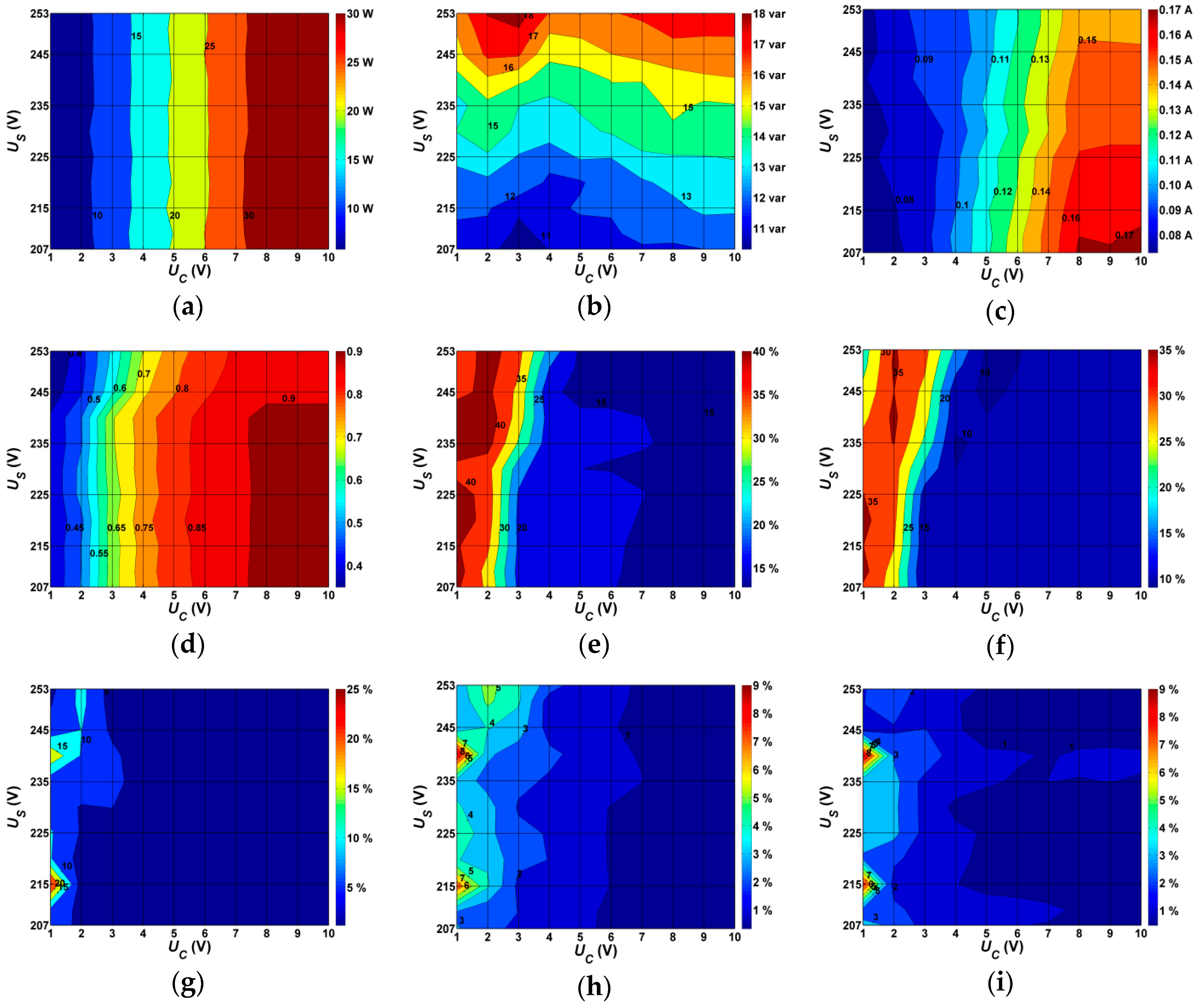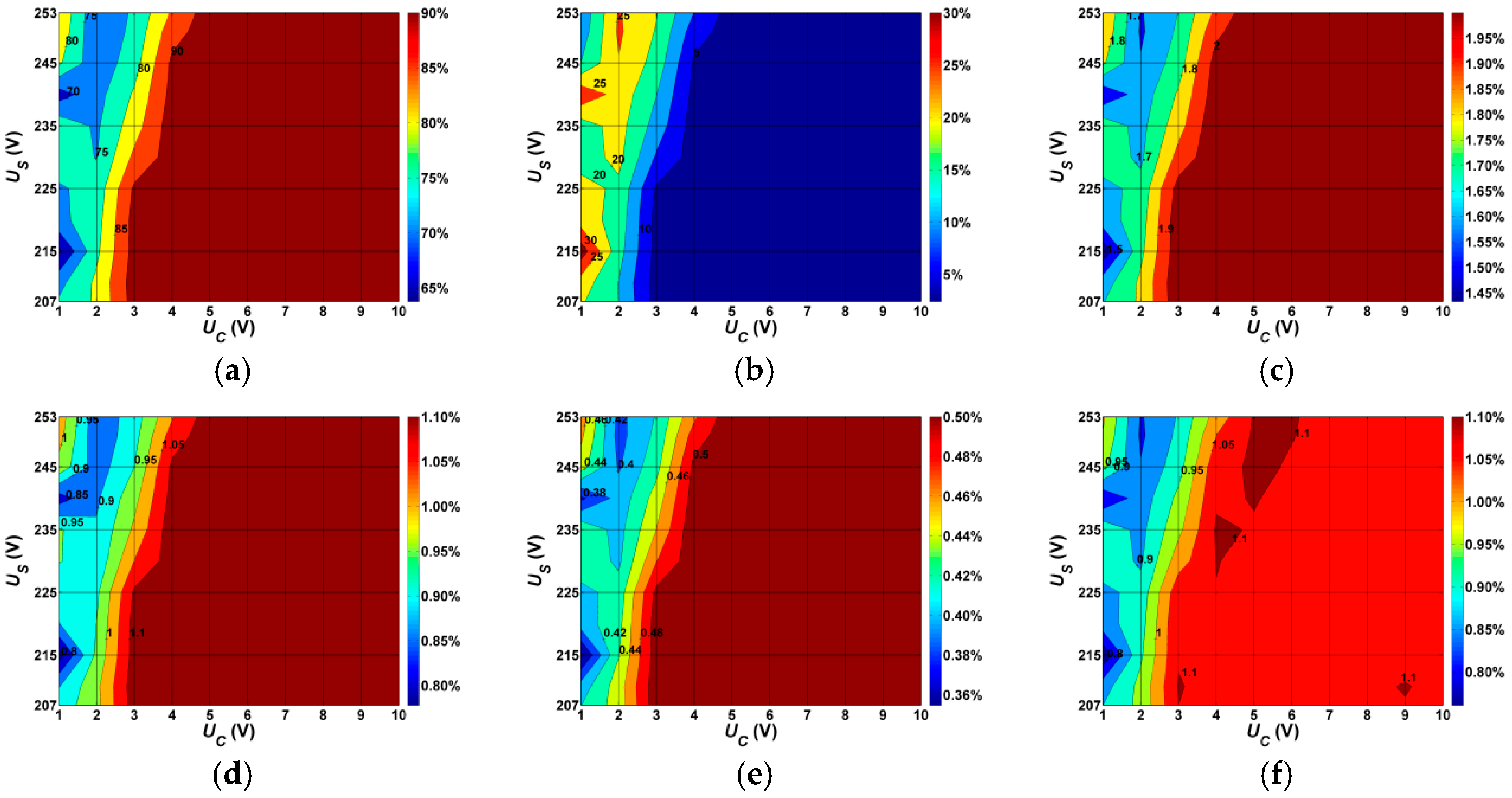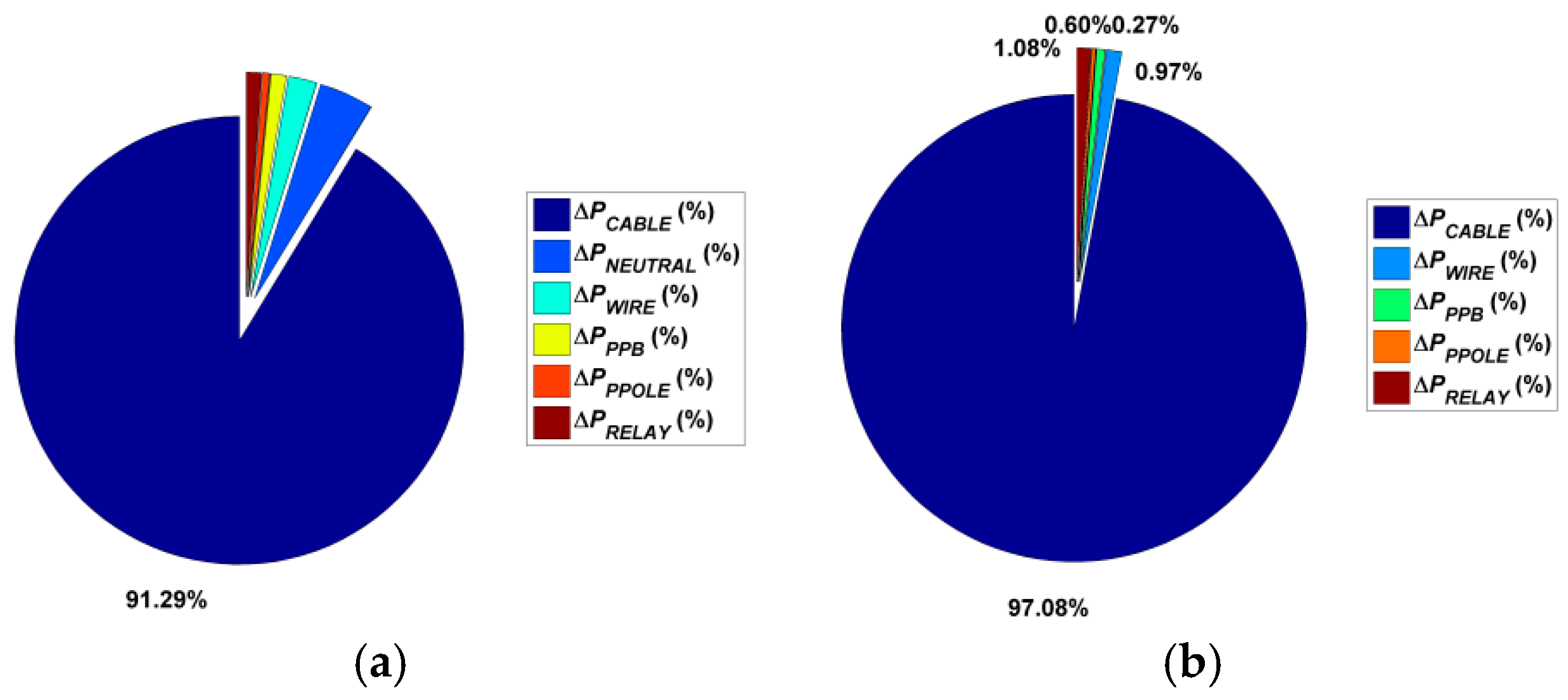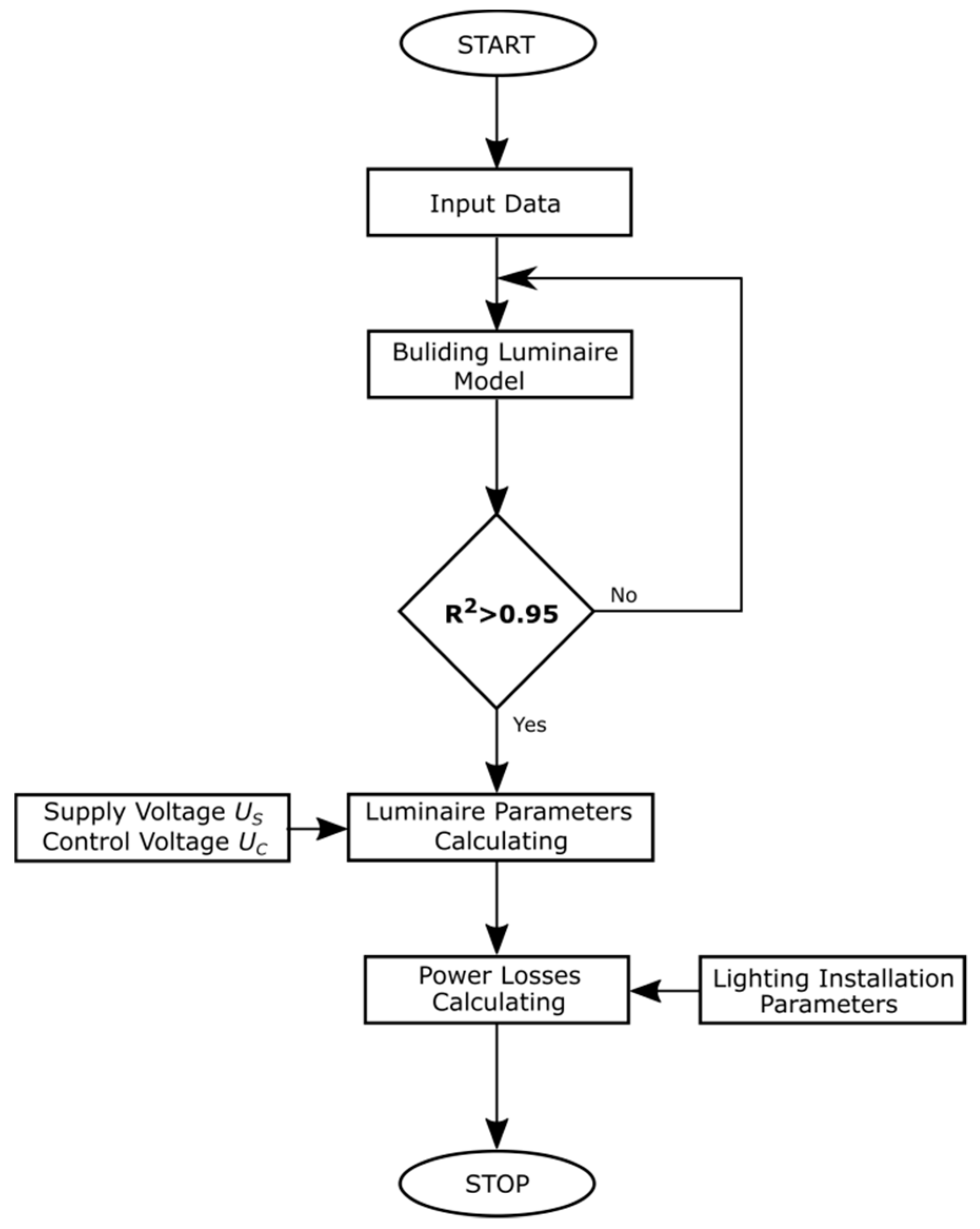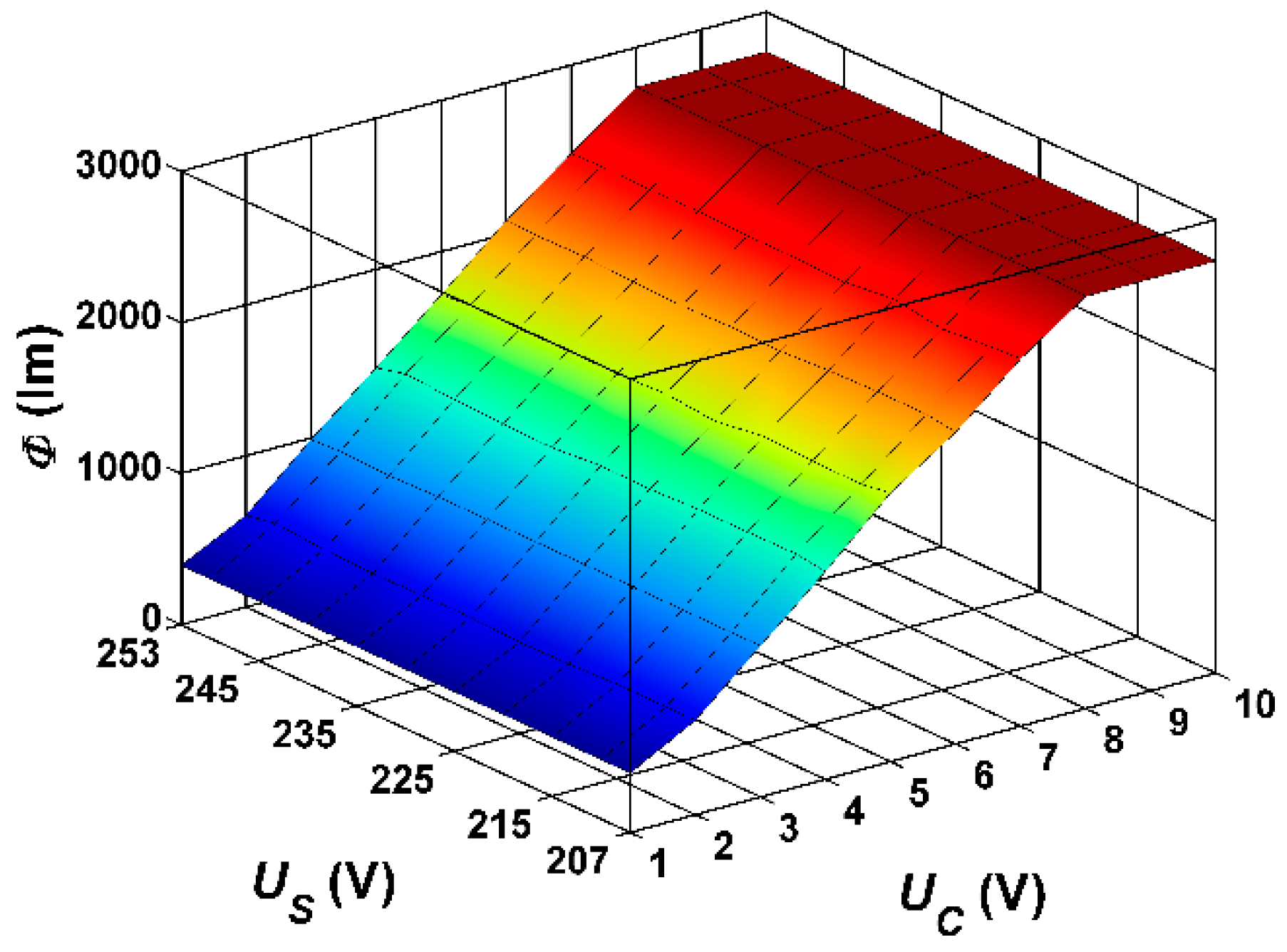1. Introduction
European Union recommendations concerning improvement in energy efficiency cover 25 areas of action under seven priorities. One of these priorities is lighting, the others being buildings, equipment, transport, industry, power plants, and interdepartmental issues [
1,
2]. Lighting is an area where energy efficiency can be improved by means of a relatively small financial expenditure [
1,
3,
4,
5,
6]. It is achieved most often by replacing light sources or by modernising or replacing luminaires. The use (although not exclusively) of modern light sources or luminaires based on LED technology makes possible the use of regulation systems [
6,
7,
8]. The simplest regulation system, and the kind most commonly used in practice, is based on an illumination schedule implemented in a luminaire controller [
8]. These schedules may be identical for all days and seasons, or may include seasonal variation. The illumination schedule determines the degree of reduction of power and luminous flux at particular times in the evening and night. The PN-EN 13201 standard [
9] permits changes in the lighting class of a road at times of lower traffic volume. A change of lighting class allows a reduction of the luminous flux of the luminaire, which is equivalent to a reduction of its power. The power reduction should not cause the illumination conditions to fall below those laid down in PN-EN 13201 [
9]. Often in practice, during the modernisation of street lighting, insufficient care is taken to ensure that the requirements of PN-EN 13201 [
9] are satisfied at reduced levels of power and illumination. Advanced (intelligent) systems of street lighting control enable the regulation of individual luminaires and of whole systems. They also enable diagnostics of luminaires and monitoring of electricity consumption [
10].
Section 5 of the standard [
9] defines indicators for evaluating the energy efficiency of street lighting, taking account of the consumption of energy when adequate street lighting parameters are maintained. One of the indicators for evaluating the energy efficiency of a lighting system is the power density index (PDI),
DP. This represents the electrical power needed to provide an adequate level of road illumination. It is computed by dividing the active power
P of the lighting system by the sum, over a set of considered horizontal planes, of the product of the average illuminance on a plane
Ei and the area of the plane
Ai:
Another indicator is the annual energy consumption index (AECI),
DE:
This is computed as the sum, over periods of operation of the system during the year, of the product of the power of the lighting system in a period (Pj) and the duration of the period (tj), divided by the area illuminated (A). The power of the lighting system P (Pj) is computed as the sum of the powers of the light sources and the total power of devices of the system necessary for its proper functioning. The value of the power of the system affects both of the above-mentioned indicators of street lighting efficiency. The standard does not specify whether power losses are to be considered in the computations, although in precise computations they should be taken into account. It would therefore appear important to estimate how the accuracy of computations of these indicators is affected by the decision to neglect or to consider power losses in the street lighting system.
Analysis of the energy efficiency of street lighting in accordance with the PN-EN 13201 standard [
9] requires knowledge of the mean illuminance on the road, the size of the area illuminated, and the power of the lighting system being considered. Computations are usually performed based on the rated powers of the luminaires, neglecting power losses in the system components. An increase in power losses will lead to an increase in consumption of active power and in electricity charges. Failure to take this issue into account during an energy audit may lead to discrepancies between the results of theoretical computations and the actual consumption of active power. The losses of active power in a street lighting system depend on the complexity of the network, the number of circuits and the numbers of luminaires in each circuit, the power supply and control devices used, the level of reactive power in the network, etc. In making an economic analysis of the losses, it is possible to describe in detail the impact of just one component of the power supply system, which may be significant in this context [
11,
12].
Active power losses in lighting networks can be reduced by using devices with regulated parameters [
13] and by limiting the reactive power in those networks [
14]. During laboratory tests of LED street luminaires with regulated power, the authors have observed that the displacement power factor and the THD (Total Harmonic Distortion) of the current depend greatly on the dimming level. In a real supply network, the voltage very often deviates from the rated value. The EN 50160 standard [
15] permits fluctuation in a supply voltage within limits of ±10%. For a single-phase network rated at 230 V, the voltage in accordance with EN 50160 [
16] may range between 207 V and 253 V. Power supply devices are currently used with different input voltage ranges, such as 198–264 V or 200–240 V. In the latter case, if the voltage supplied is greater than 240 V, the device will be operating in conditions for which it was not designed. To determine the effect of the supply voltage at different dimming levels, measurements were made on a street luminaire, and based on those measurements a calculation was made of the power losses in a sample lighting system; this is the chief topic of this article. Both single-phase and three-phase systems were considered. Computations were performed for supply voltages in the interval 230 V ±10% and for ten dimming levels.
The article is structured as follows:
Section 2 describes the methodology for computing power losses in individual elements of a lighting system.
Section 3 presents the characteristics of the tested luminaire and the measurement results.
Section 4 contains the results of computations of power losses in the analysed street lighting system based on a mathematical model of a luminaire.
2. Computing Power Losses in Street Lighting Systems
This chapter concerns the formulae used to compute active power losses in a single-phase or three-phase street lighting system. In view of the low values of the reactance of elements of the system, reactive power losses are neglected here. Active power losses are denoted by Δ
PTOTAL1p for a single-phase system and by Δ
PTOTAL3p for a three-phase system. Total active power losses are the sum of the power losses occurring in the power supply cable (Δ
PCABLE), the safety device for the supply cable located in the lighting system distribution board (Δ
PPPB), the relay controlled by an astronomical clock (or other control device) in the distribution board (Δ
PRELAY), the safety device located in a recess in the pole (Δ
PPPOLE) and the wire connecting the pole fuse box to the luminaire (Δ
PWIRE). In the case of a three-phase system, account is also taken of the active power loss Δ
PNEUTRAL in the neutral conductor of the cable. Total active power losses for a three-phase lighting system Δ
PTOTAL3p are given by:
For a single-phase system, total active power losses amount to:
For a three-phase lighting system, active power losses in the power supply cable can be computed from Equation (5) described in [
17]:
where:
In the case of a single-phase system, power losses in the supply cable can be computed from Equation (9):
where:
In formulae (5)–(11) the symbols have the following meanings:
RL—resistance of the cable wire between poles (Ω);
n—number of luminaires per phase;
l01—distance of the first luminaire from the lighting system distribution board (m);
l—distance between poles (m);
γC—specific conductance of the conductors of the supply cable (m/Ωmm2);
SC—cross-sectional area of the conductors of the supply cable (mm2);
ILum—RMS (Root Mean Square) current of the luminaire (A).
Active power losses in the neutral conductor of the supply cable are generated by the flow of higher harmonics in the zero sequence whose orders are multiples of three. These losses can be computed from Equation (12) or (17):
or:
where:
RN is the resistance of the neutral wire (Ω);
IhLum is the RMS current of the h-th harmonic in the zero sequence for h = 3, 9, 15, …, (A);
INLum is the RMS current flowing in the neutral conductor (A).
Power losses in the wire connecting the pole fuse box to the luminaire are computed from Equation (18):
where:
lPW is the length of the wire connecting the pole fuse box to the luminaire (m);
γC is the specific conductance of the conductors of that wire (m/Ωmm2);
SC is the cross-sectional area of the conductors of that wire (mm2);
RPW is the resistance of cable wire (Ω).
Power losses in safety devices may be computed based on the rated values of active power losses Δ
PPD provided in the manufacturer’s catalogue. Knowing the rated active power losses and the rated current
IRPD, the resistance of the device is given by the simple Equation (19):
If the value of the resistance is known, then computation of the power losses is a simple task. If a fuse is used as the protective device, then the total active power losses are the sum of the power losses in the fuse base and the fuse element. The value of the power losses in the relay may be computed analogously.
3. Results of Measurements
The device selected for testing was an LED street luminaire with a rated power of 32 W. The luminaire has a power supply with analogue control input on a 1–10 V standard, with rated input voltage 120–277 V. Dimming of the luminaire is regulated by changes in the value of the control voltage UC between 1 V and 10 V, with a step size of 1 V. A laboratory power supply device was used as the source of the DC control voltage. The luminaire was powered by a 6834B supply device (Agilent, Palo Alto, CA, USA). It was assumed that in the power supply network, in accordance with the EN 50160 standard, the value of the phase voltage will remain in the range 230 V ± 10%, that is, from 207 V to 253 V. Measurements were made for voltages US = (207, 210, 215, 220, 225, 230, 235, 240, 245, 250, 253) V and based on the assumption that the supply voltage is pure sinusoidal (without distortions). Measurements of electrical parameters were made using a 1760 electrical energy quality analyser (FLUKE, Everett, WA, USA).
Figure 1a shows changes in the active power of the luminaire as a function of the supply voltage
US and the control voltage
UC. It shows that the relationship is linear as regards control voltages. In the range
UC = 8–10 V it can be assumed that the luminaire is operating at full power. The value of the active power of the luminaire is practically independent of the supply voltage within the range of variation analysed. The reactive power
Q (
Figure 1b) increases with a rise in the supply voltage
US. In contrast to the active power, the reactive power is seen to be strongly dependent on the supply voltage. However, no significant variation in the reactive power is observed depending on the control voltage. Since the current drawn by the luminaire is composed of active and reactive components, it is seen to depend on both the supply and control voltage (
Figure 1c).
The luminaire draws its maximum current when it operates at full power and is supplied with a voltage of 207 V. The displacement power factor
PFD as a function of supply voltage and control voltage is shown in
Figure 1d. Like other LED luminaires, the tested luminaire has a capacitive power factor for all dimming levels and for the entire range of analysed supply voltages. The power factor is found to be strongly dependent on the control voltage. When the luminaire operates at lower power, the value of this factor decreases, reaching a value of around 0.35 when the supply voltage is 253 V and
UC = 1 V. The next electrical parameter to be analysed is the current distortion factor
THDI (
Figure 1e). When
THDI is analysed as a function of the supply voltage
US and the control voltage
UC, two different zones of variation are observed. For control voltages above 5 V the value of
THDI for current drawn from the network varies over a narrow range. However, as the control voltage falls from 5 V to 1 V, the value of
THDI rises sharply. The maximum value of
THDI is 44.59% (for
UC = 1 V and
US = 235 V), three times higher than the value obtained when the luminaire operates at full power. Such a large growth in the higher harmonics generated in the supply network may lead to a number of undesirable phenomena, as described widely in the literature [
13,
18,
19,
20].
Figure 1f–i show how the higher harmonics of the current of the tested luminaire depend on the voltages
US and
UC, for the third, ninth, 15th and 21st harmonics respectively. The values of these harmonics are selected because they are used for computation of the power losses in the neutral conductor of the supply cable. The greatest variation can be observed in the case of the third harmonic, which reaches its highest values for control voltages of 1–4 V.
In summary, two ranges of operation of the tested luminaire may be distinguished, based on the value of the control voltage UC: the first for UC = 1–5 V, and the second for UC = 5–10 V. In the first range the current distortion (represented by values of THDI) is strongly dependent on the dimming level. In the second range there is virtually no such dependence. This leads to the practical conclusion that if it is required that the luminaire should not generate excessive distortions in the supply network in the form of higher current harmonics, then the control voltage should be maintained between 5 V and 10 V. Bearing in mind that in the range UC = 8–10 V the luminaire operates at full power, the width of the regulating voltage range would then be reduced to 4 V, and the luminaire could be set to operate at between 50 and 100% power. Reducing the range of regulation will reduce variation in the displacement power factor of the luminaire. This is important if the owner of the street lighting system pays for both active and reactive energy consumption, or pays additional charges as a penalty for exceeding the permissible value of the parameter tanϕ.
5. Mathematical Model of a Luminaire for Computation of Active Power Losses
To compute power losses in a three-phase network, it is sufficient to have knowledge of parameters of the regulated luminaire such as the active power, power factor and reactive power. If the computations of active power losses for a three-phase network are to take account of losses in the neutral conductor, then it is also necessary to have knowledge of the harmonic currents in the zero sequence with orders being multiples of three.
As has been shown in the foregoing chapters, the electrical parameters of a luminaire and the active power losses depend on two variables: the supply voltage
US and the dimming control voltage
UC. Using the developed model it is possible to determine the parameters of the luminaire which will serve as input data for the computation of active power losses in the lighting system, namely the active power
P, the displacement power factor
PFD, the RMS supply current
I, and the RMS values of the current harmonics
Ihn, where
n is the order of the harmonic. A luminaire, as a nonlinear electrical load, is a source of higher harmonics of the supply current [
13,
19,
20].
The developed model enables computation of the electrical parameters of a luminaire for control voltages in the range 1–10 V and supply voltages in the range 207–253 V. The voltages in a real distribution network usually lie between these limits. Using the model, the active power losses may be determined for any supply voltage from this range and for any dimming level. In this way one may compute both the power losses and the power of the lighting system as a whole. These data will enable precise calculation of the energy efficiency of the street lighting system. Using the method of linear regression, based on the measurement data, approximating polynomials were determined for electrical parameters such as the active power and the displacement power factor
PFD (cos
ϕ) [
21,
22,
23,
24]. Approximating polynomials for the active power of the luminaire, the power factor and the RMS supply current are given in
Table 7 below. For the mathematical description of these phenomena one may use models of a nonlinear load based, for example, on its design [
16,
25,
26]. The method given here for determining power losses may be used not only for luminaires, but also for other load devices with nonlinear current-voltage characteristics [
18,
27,
28,
29,
30].
The mean square error R2 for the polynomial approximating the value of the active power as a function of the voltages UC and US is 0.9979. For the polynomial approximating the displacement power factor PFD(UC,US) we have R2 = 0.9953, and for the polynomial approximating the value of the RMS current we have R2 = 0.9967.
In the computations of power losses, account is taken of such harmonics as
Ih3,
Ih9,
Ih15,
Ih21,
Ih27,
Ih33 and
Ih39. The even harmonics are neglected, since they take only small values. Linear regression was used to determine approximating polynomials for these values, but the results were not satisfactory: the R
2 error exceeded the set limit of 10%. For this reason, to model the harmonics, the method of cubic spline interpolation was used. The matrix notation for cubic spline interpolation is:
or:
where:
This method enabled the prediction of higher current harmonics with an accuracy that was adequate from a practical point of view. For regressions of this type, the mean square errors R2 are equal to 1.
Using the developed model, electrical parameters may be determined for any supply voltage
US in the range 230 V ±10% and for dimming levels ranging from 10% to full power. Computations were performed for sample input data; the results are given in
Table 8. In practical computations, account must be taken of the illumination schedule defined for the luminaires and the consequent dimming levels, which must comply with the illumination requirements for the road in question, in accordance with the standard [
9]. Values of the RMS supply voltage result from the conditions of the power supply to the lighting system distribution board.
Knowing the values of the electrical parameters for the assumed values of
US and
UC, it is possible to determine the separate components of the active power losses. To do this, the concrete numerical values of the electrical parameters given in
Table 8 were substituted into Equations (3)–(19). The results of the computations appear in
Table 9.
The values of ΔPTOTAL, ΔPa and ΔPr are expressed as percentages of the rated power for the analysed lighting system (30 luminaires). For the remaining parameters, the values represent the percentage contributions of the individual components to the total power losses.
Figure 6 shows the proposed method of determining total losses using the developed model, in the form of an algorithm. The input data are the measured characteristics of changes in the analysed basic electrical parameters depending on the value of the RMS supply voltage and the dimming level. The range of variation of the supply voltage results from the requirements of the EN 50160 standard [
16], and the considered variation in the dimming level should cover the complete range available for the luminaire. For obvious reasons, increasing the number of analysed points improves the accuracy of the computed characteristics, but at the cost of increasing the quantity of work. To obtain a desired accuracy of 5%, the number of measurement points given in
Table 4 can be considered sufficient.
At the next stage, a mathematical model of the luminaire is constructed, and the mean square error value is checked. If the error exceeds the set limit, the construction process is repeated with an adjustment to the degree of the approximating polynomials, or else a different regression method is adopted. At the start of model construction the degrees of the polynomials are taken as small as possible; higher-degree polynomials are used if the accuracy needs to be improved. When the mean square error is found to be at an acceptable level, work on the construction of the model is complete. For any values of the input data (
US and
Uc) the model can be used to determine the electrical parameters; sample values of these are given in
Table 8. Based on the parameters of the lighting system, particular components of the active power losses may be determined (sample values appear in
Table 9) based on the analytical equations given in
Section 2. The parameters of the lighting system include values such as the number of lamps, the power of each lamp, the cross-sectional area, length and type of the supply cables, and so on.
6. Conclusions
Any lighting system ought to offer high energy efficiency. Lighting is an area in which efficiency can be significantly improved by means of a relatively small amount of financial expenditure.
Section 5 of the standard [
6] defines indicators for evaluation of the energy efficiency of street lighting, taking account of the consumption of energy while adequate street lighting parameters are maintained. One of the indicators for evaluation of the energy efficiency of a lighting system is the power density
DP. This value is directly proportional to the active power of the system, and inversely proportional to the value of the mean illuminance and illuminated area. One of the components of the active power, alongside the utilised power of the luminaires, is the active power losses occurring in the various components of the system. With regard to the possibility of using luminaires with regulated power, operating according to a defined schedule, it is necessary to choose the technical solution that will provide the best energy efficiency. Analysis of the energy efficiency of street lighting in accordance with the PN-EN 13201 standard [
9] requires knowledge of the mean illuminance on the road, the size of the illuminated area, and the power of the lighting system under consideration. Computations are usually performed based on the rated powers of the luminaires, neglecting power losses in the devices of which the system is composed. An increase in power losses will lead to an increase in the active power consumed, and in the cost of the electricity used. Failure to take account of this factor in energy audits may lead to discrepancies between the computed theoretical values and the actual values of active power consumed. An increase in power losses will cause a reduction in the DP factor. that is with the deterioration of energy efficiency of the lighting installation.
This article has described a method of determining the power losses occurring in a lighting system, depending on the power supply conditions and the dimming level. The components of active power losses and analytical methods for their determination are introduced in
Section 2. The method used to determine the losses is dependent on the configuration of the supply network, that is, whether it is single-phase or three-phase. Total active power losses are presented here as the sum of individual components, such as the losses in the working conductors of the supply cable, in the neutral conductor for three-phase systems, and in other devices of the power supply system. Since the proposed method of determining losses is based on a mathematical model,
Section 3 contains a presentation of results of measurements to determine how the electrical parameters of a luminaire, such as the active power
P, the reactive power
Q and the factor
THDI, depend on the RMS supply voltage and the dimming level. Construction of the mathematical model for a luminaire involves the use of an approximating polynomial [
21,
22,
29,
31] or cubic spline interpolation, depending on the output parameter being analysed.
Section 4 includes sample results of computations of active power losses, including values for the losses resulting from the flow of active and reactive power. These computations were performed for assumed parameters of the lighting system. The algorithm for construction of the model is described in detail in
Section 5. Results are given for computations of active power losses for arbitrary values of the supply voltage and the dimming level of the luminaire. The algorithm is shown in diagram form in
Figure 6. Given the mathematical model for a luminaire, one may determine the level of losses for any chosen value of RMS supply voltage
US and dimming level (control voltage)
UC, and thereby, for example, select a dimming regulation schedule in such a way as to minimise those losses. This means that, during the design of the system, it becomes possible to select a solution offering the highest energy efficiency, and consequently the lowest operating costs.
The characteristics of the luminous flux of the tested luminaire as a function of the control voltage
UC and the supply voltage
US are shown in
Figure 5. In the range of control voltages from 1 V to 8 V, the luminous flux increases linearly to the full value (
Figure 7). For
UC voltages ≥ 8 V, the luminous flux does not change. The relationship between the percentage of active power and the luminous flux of the luminaire considered is shown in the
Figure 8. This dependence is linear.
